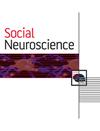Sensorimotor anticipation of others’ actions in real-world and video settings: Modulation by level of engagement?
IF 1.7
4区 医学
Q4 NEUROSCIENCES
引用次数: 0
Abstract
ABSTRACT Electroencephalography (EEG) studies investigating social cognition have used both video and real-world stimuli, often without a strong reasoning as to why one or the other was chosen. Video stimuli can be selected for practical reasons, while naturalistic real-world stimuli are ecologically valid. The current study investigated modulatory effects on EEG mu (8–13 Hz) suppression, directly prior to the onset – and during the course – of observed actions, related to real-world and video settings. Recordings were made over sensorimotor cortex and stimuli in both settings consisted of identical (un)predictable object-related grasping and placing actions. In both settings, a very similar mu suppression was found during unfolding of the action, irrespective of predictability. However, mu suppression related to the anticipation of upcoming predictable actions was found exclusively in the real-world setting. Thus, even though the presentation setting does not seem to modulate mu suppression during action observation, it does affect the anticipation-related mu suppression. We discuss the possibility that this may be due to increased social engagement in real-world settings, which in particular affects anticipation. The findings emphasize the importance of using real-world stimuli to bring out the subtle, anticipatory, aspects related to action observation.在现实世界和视频环境中对他人行为的感觉运动预期:参与程度的调节?
摘要:研究社会认知的脑电图研究既使用了视频刺激,也使用了现实世界的刺激,通常没有强有力的理由来解释为什么选择其中一种。视频刺激可以出于实际原因进行选择,而自然的现实世界刺激在生态上是有效的。目前的研究调查了在观察到的动作开始之前和过程中,与真实世界和视频设置相关的对EEGμ(8-13 Hz)抑制的调节效应。在感觉运动皮层上进行记录,两种环境中的刺激都包括相同(不)可预测的与物体相关的抓握和放置动作。在这两种情况下,无论可预测性如何,在动作展开过程中都发现了非常相似的μ抑制。然而,与对即将到来的可预测行动的预期相关的mu抑制仅在现实世界中被发现。因此,即使在动作观察期间,呈现设置似乎不会调节μ抑制,但它确实会影响与预期相关的μ抑制。我们讨论了这可能是由于现实世界环境中社会参与度的增加,这尤其影响了预期。研究结果强调了使用真实世界的刺激来展现与动作观察相关的微妙、预期方面的重要性。
本文章由计算机程序翻译,如有差异,请以英文原文为准。
求助全文
约1分钟内获得全文
求助全文
来源期刊

Social Neuroscience
医学-神经科学
CiteScore
3.40
自引率
5.00%
发文量
36
审稿时长
6-12 weeks
期刊介绍:
Social Neuroscience features original empirical Research Papers as well as targeted Reviews, Commentaries and Fast Track Brief Reports that examine how the brain mediates social behavior, social cognition, social interactions and relationships, group social dynamics, and related topics that deal with social/interpersonal psychology and neurobiology. Multi-paper symposia and special topic issues are organized and presented regularly as well.
The goal of Social Neuroscience is to provide a place to publish empirical articles that intend to further our understanding of the neural mechanisms contributing to the development and maintenance of social behaviors, or to understanding how these mechanisms are disrupted in clinical disorders.
 求助内容:
求助内容: 应助结果提醒方式:
应助结果提醒方式:


